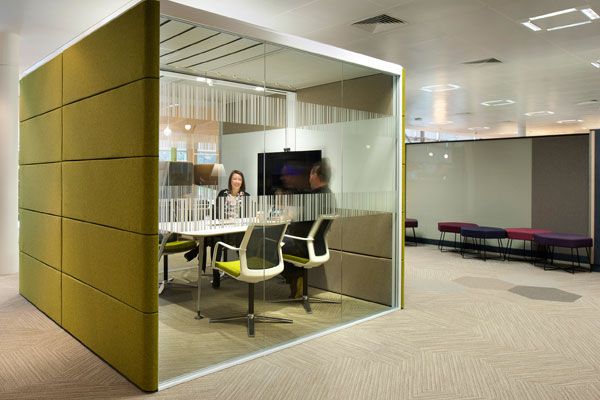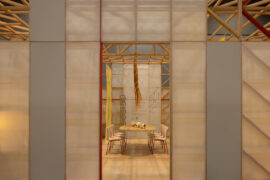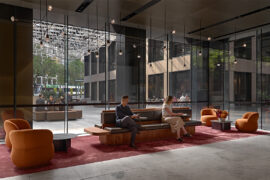Alexi Robinson considers Smith’s Cooper-Hewitt exhibition and related essay, Design for the Other 90%, against her findings at this year’s Milan Furniture Fair.
May 29th, 2008
Design for the Other 90% is a provocative read for any designer let alone one on route to the perceived mecca of all that is forecasting in design. “Ninety-five percent of the world’s designers focus all of their efforts on developing products and services exclusively for the richest ten percent of the world’s customers”, it reads, unashamedly factual in tone. With this lingering in mind and the gravitational pull of the world’s most prestigious furniture trade show extracting thought process and creativity around me, I wondered about design. I wondered about its defining role as a tool for improving lifestyle and it’s overlooked one as a tool for improving life.
Thoughts aside, I went on to gather several parallel points of view warranting usage of the word trend, their vying for attention falling short of the overtly fashioned corporate advertising via design that festooned itself around the city.
While a steady utilitarian approach emerged in a series of sensible looking furniture less concerned with sculptural impersonation and more with the ability to withstand time, it was the non-solid surface that reigned triumphant through the hole-punching, metal weaving and thermoplastic polymer threading tested in new work from Konstantin Grcic and Patricia Urquiola.
There was no absence of colour, from the bold to the ‘oh so now’ fluorescents, with some companies like Cartel presenting an almost excessive fifteen to twenty colour variants. Adaptability surfaced in pieces eager to fold, slide or change shape for multi-functional, space saving or just plain illusion sake. Capellini introduced the Stitch chair by designer Adam Goodrum while Shay Alkalay dreamt up a frameless drawer system for Established and Sons.
Playing the history card had a strong presence this year, not only through the reinterpretation of classic forms but through archival scouring for examples of modernist design, a move of commercial sense at a time when 20th-century designs are breaking records at auction. The 83-year-old, family-run Italian company, Porro, reintroduced a sleek 1960’s trolley by Bruno Munari while a welcome revival played out at the Triennale Museum from French silverware maker, Christolfe, for which the Italian architect Gio Ponti designed for throughout his career.
The revival of historic production processes was equally present and in a crescendo of showmanship by British company Meta, ‘antiques of the future’ was coined to describe the combining of Europe’s finest artisans with precious materials to create 21st century design at a quality once seen at the heights of the decorative arts. An antique, as it stands, is an old collectible item desirable because of its age, rarity, utility or condition; an object that represents a previous era in human society. When Mallet Antiques decided to unveil its new face on to Milan as a commissioner of avant-garde design it was, therefore, hard to dismiss the resulting collection as a projection of cultural values today.
The philosophy behind Meta is clearly an opportunistic response to a burgeoning marketplace swallowing up 21st century design able to provoke in a manner not dissimilar to contemporary art. But such shift in strategy is not without cultural or intellectual content; indeed such branching out might be inscribed historically as the stepping-stone to a movement unbeknown to design.
More interestingly to watch is how far the definition of design further evolves into opulence and in which direction it decides to stray once confounded by its destination. Preciousness and perception are interchangeable entities and in no greater context is their reliance on one another felt than in art. Design has transgressed to such flowering of the imagination but unlike art is inherently dogged by its ability to be useful.
In Meta we have design which benefits from a largely uncommon selection of materials and techniques enabling rarity and appeal to be design engineered into the blueprint of its creation. In Meta we also have design so removed from usefulness outside its immediate realm, even distant association to function might be a big ask from its alternative customer.
So what happens when some of the finest, most inquisitive minds of our time apply themselves not only to finding solutions to an enormity of problems in the developing world but go about it in a way that makes permissible the realignment of value from the exotic to the just plain clever?
As I swigged back another sponsored martini in the hope for answers, I came to the conclusion that the Salone del Mobile can be a dispiriting showground of design infatuation if recontextualised against the other ninety percents reality of needs. It seems innovation is everywhere, from Grcic’s Myto Chair to the four-layer opaline glass of Cupola for Meta, but as my time in Milan drew to a close I was no closer to considering my reading material as anything other than a foreign object in my bag, its place unsure of in the design community I frequented, its relevance no less immeasurable.
To be continued.
Alexi Robinson is indesignlive’s UK editor. An Aussie expat living in London, working for design legend Tom Dixon, who better to send us a monthly report on the ever dynamic design scene over the sea.
Links:
www.madebymeta.com
http://other90.cooperhewitt.org/
http://www.designws.com/pagina/1artecnica07.htm
INDESIGN is on instagram
Follow @indesignlive
A searchable and comprehensive guide for specifying leading products and their suppliers
Keep up to date with the latest and greatest from our industry BFF's!

It’s widely accepted that nature – the original, most accomplished design blueprint – cannot be improved upon. But the exclusive Crypton Leather range proves that it can undoubtedly be enhanced, augmented and extended, signalling a new era of limitless organic materiality.

Welcomed to the Australian design scene in 2024, Kokuyo is set to redefine collaboration, bringing its unique blend of colour and function to individuals and corporations, designed to be used Any Way!

A curated exhibition in Frederiksstaden captures the spirit of Australian design

Gaggenau’s understated appliance fuses a carefully calibrated aesthetic of deliberate subtraction with an intuitive dynamism of culinary fluidity, unveiling a delightfully unrestricted spectrum of high-performing creativity.

Why build walls? This simple yet significant question drove the development of a new family of demountable meeting room pods for Haworth xFriends.
The internet never sleeps! Here's the stuff you might have missed

The collaboration between Nexus Designs and Cultivated challenge conventional design practices, offering tangible solutions for the industry’s sustainability challenges.

Grimshaw has completed a revitalisation of Collins Place, adding new layers to an already historically and architecturally rich site in Melbourne’s CBD.